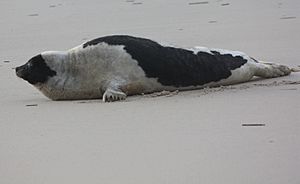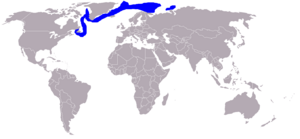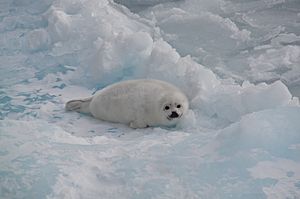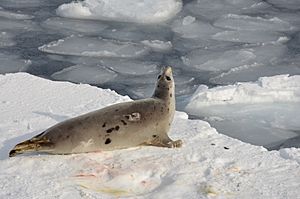Harp seal facts for kids
Quick facts for kids Harp seal |
|
|---|---|
 |
|
| Conservation status | |
| Scientific classification | |
| Genus: |
Pagophilus
|
| Species: |
groenlandicus
|
 |
|
| Synonyms | |
|
Phoca groenlandica |
|
The harp seal (Pagophilus groenlandicus) is also known as the Saddleback Seal or Greenland Seal. It's a type of earless seal that lives in the northern Atlantic Ocean and Arctic Ocean. Its scientific name, Pagophilus groenlandicus, means "ice-lover from Greenland." This seal is the only species in its group, called Pagophilus.
Contents
Description
Adult harp seals have shiny black eyes and silver-gray fur. They have a special black marking on their back that looks like a harp or a wishbone. These seals grow to be about 1.7 to 2.0 meters (5.6 to 6.6 feet) long. They usually weigh between 115 and 140 kilograms (254 to 309 pounds).
When a harp seal pup is born, its fur is often yellowish-white. This color comes from the fluid it was in before birth. After a few days, the fur turns pure white. It stays white for about 2 to 3 weeks until the pup sheds its first coat. Young harp seals, called adolescents, have silver-gray fur with black spots.
Male harp seals are a bit bigger than females. Males weigh around 135 kg (298 lbs) and can be up to 1.9 m (6.2 ft) long. Females weigh about 120 kg (265 lbs) and reach up to 1.8 m (5.9 ft). Males usually have a clearer harp-shaped mark on their back and a darker head. Some females never get this distinct mark and stay spotted.
Diving Abilities
Harp seals can dive to different depths, from shallow to quite deep. How deep they dive depends on the season, time of day, and where they are. In the Greenland Sea, they dive about 8 times per hour. These dives can be from less than 20 meters (66 feet) to over 500 meters (1,640 feet) deep. Each dive can last from less than two minutes to over 20 minutes.
During spring and summer, when seals look for food near the ice in the Greenland Sea, most of their dives are less than 50 meters (164 feet). In late fall and winter, they dive deeper. For example, in the Denmark Strait, their average dive depth was 141 meters (463 feet).
Mother harp seals who are nursing their pups spend most of their time in the water. They spend about 80% of their time swimming and 20% on the ice with their pups. They often stay near the surface of the water to save energy. This also helps them avoid the harsh weather on the ice while staying close to their babies.
How They Stay Warm
Harp seals have special ways to keep warm. Young pups rely on their thick fur, called lanugo, to stay warm while nursing. This fur traps a layer of air to insulate them. After about a year, they develop a layer of blubber (fat) under their skin. This blubber is much better for keeping warm in the water than their fur.
Adult harp seals mainly use their blubber for insulation. Blubber not only keeps them warm but also stores energy for when food is scarce. It also helps them swim smoothly through the water. Their flippers also help control their body temperature. They can change blood flow to their flippers to release or keep heat as needed. When on ice, they can press their flippers close to their bodies to reduce heat loss.
Senses
Harp seals have large eyes that help them see well underwater. Their eyes have a special lens that helps them focus. They also have a mobile pupil, which helps them adjust to the bright glare of the Arctic ice. Their eyes are very good at seeing in low light, like a cat's eyes. This helps them see in the dim underwater world.
On land, mother seals use their sense of smell to find their pups. Smell can also warn them if a predator is nearby. When underwater, seals close their nostrils, so they cannot smell.
Their whiskers, called vibrissae, are very important for touch. They are arranged in rows on each side of their snout. Underwater, these whiskers can sense small movements and vibrations, helping them find food or avoid danger.
Diet
Harp seals are carnivorous, meaning they eat meat. They have a varied diet that includes many types of fish and small sea creatures. The seals from the White Sea travel north in the summer to find food in the Barents Sea. There, they often eat krill, capelin, herring, flat fish, and other fish.
Harp seals might prefer certain foods, but they mostly eat what is easiest to find. For example, seals near Svalbard mostly eat krill and polar cod. Seals in the Barents Sea eat more herring and polar cod, as they dive deeper than where krill usually are.
Harp seals in the western North Atlantic, near Newfoundland, eat Arctic cod, capelin, Greenland halibut, and American plaice. Capelin is a favorite food in both coastal and offshore areas.
Life History
Harp seals spend most of their lives in the ocean. They are very social animals and live in large groups. Within these big groups, smaller families form. During the time when they have pups and mate, groups can grow to several thousand seals. Harp seals can live for more than 30 years in the wild.
On the ice, pups make "yelling" sounds to call their mothers. They also "mumble" when they play with other pups. Adult seals "growl" and "warble" to warn other seals or predators to stay away. Underwater, adult seals use many different sounds when they are looking for a mate.
Reproduction and Life Cycle
Harp seals usually breed between mid-February and April. Males try to attract females by performing underwater displays. They use bubbles, sounds, and paw movements to impress them. While the courtship starts on the ice, mating usually happens in the water.
Female seals are ready to have pups when they are about five or six years old. After that, they usually have one pup each year, typically in late February. Twin births are very rare.
Newborn pups weigh about 11 kg (24 lbs) and are about 80 to 85 cm (31 to 33 inches) long. The mother only feeds her own pup. During the nursing period, which lasts about 12 days, the mother does not hunt for food. She can lose up to 3 kg (6.6 lbs) of weight each day. Harp seal milk is very rich in fat, starting at 25% fat and increasing to 40% by the time the pup is weaned. Pups gain over 2.2 kg (4.9 lbs) per day while nursing. This helps them quickly build up their blubber layer. During this time, the pup's "greycoat" starts to grow under its white baby fur. The pup's weight increases to about 36 kg (79 lbs).
After the mother leaves, the pup enters a phase where it stays still to save its body fat. Within a few days, it sheds its white coat. At this stage, it's called a "beater." This name comes from the sound its tail makes as it learns to swim. Pups start to feed on their own at about 4 weeks old. However, they still use their stored energy, especially from their body core, before relying on their blubber. During this time, the ice starts to melt, which can make them vulnerable to polar bears and other predators. Many pups lose a lot of weight during this period. Sadly, up to 30% of pups die in their first year, partly because they can't move well on land at first.
Around 13 to 14 months old, the pups shed their fur again and are called "bedlamers." Young seals molt several times, developing a "spotted harp" pattern. The full harp-shaped marking on males appears after several years. Females do not develop this distinct marking.
Every year, seals gather on the ice to molt (shed their fur), have pups, and breed. After this, they travel to their summer feeding grounds. Their lifespan can be over 30 years.
Distribution
There are about 4.5 million harp seals in the world. The largest group lives off eastern Canada. This group is divided into two herds based on where they breed. The "Front herd" breeds off the coast of Labrador and Newfoundland. The "Gulf herd" breeds near the Magdalen Islands in the Gulf of St. Lawrence.
Another group breeds off eastern Greenland, called the "West Ice." A third group breeds in the "East Ice" in the White Sea, off the north coast of Russia. These three groups usually do not mix or breed with each other.
There are two recognized types of harp seals:
| Image | Subspecies | Distribution |
|---|---|---|
 |
Pagophilus groenlandicus groenlandicus | Eastern Canada to Norway |
| Pagophilus groenlandicus oceanicus | White and Barents seas |
Migration and Travel
Harp seals travel long distances. The group in the northwest often moves up to 4,000 kilometers (2,500 miles) northeast after the breeding season. One seal was found 4,640 km (2,880 miles) from where it was tagged! They are very good at finding their way, and their excellent eyesight helps them navigate.
Sometimes, harp seals wander far south of their usual homes. For example, in 1987, many harp seals moved into Norwegian waters. This was likely because there wasn't enough food for them due to commercial fishing. Many seals were found weak and hungry.
Harp seals can sometimes end up on Atlantic coasts, especially in warmer months. This can happen if they are dehydrated or have many parasites. In mild winters, they might not have enough snow to eat for hydration. Several groups help rescue and care for seals that are in trouble. In the United States, harp seals are protected by the Marine Mammal Protection Act.
Seal Hunting
All three groups of harp seals are hunted for commercial reasons. The main countries that hunt them are Canada, Norway, Russia, and Greenland.
In Canada, the commercial hunting season is from November 15 to May 15. Most of the hunting happens in late March in the Gulf of St. Lawrence. It also takes place in April off Newfoundland, in an area called "the Front." This spring hunting period is often called the "Canadian seal hunt." Hunting whitecoat pups has been banned in Canada since 1987. Since 2000, most harp seals hunted are less than a year old, known as "beaters." Inuit people living in the region hunt seals mainly for food and sometimes for trade.
The Canadian government monitors the seal hunt. They set limits on how many seals can be caught each year to make sure the population stays healthy. For example, in 2016, about 66,800 harp seals were caught in Atlantic Canada.
In 2005, a group of veterinarians suggested a three-step process for hunters to kill seals quickly and with little pain. This process was later included in Canadian hunting rules. The steps are:
- First, stun the seal on the head with a rifle or club to kill it or make it lose consciousness right away.
- Second, make sure the skull is badly damaged to confirm the seal is unconscious.
- Third, cut the arteries in the armpits and along the belly to stop blood flow to the brain, ensuring the seal is dead.
The annual hunting limit off the coast of Greenland for 2017–2019 was 26,000 seals.
Population Changes
Hunting has greatly affected the number of harp seals over time. In the past 150 years, the harp seal population has changed a lot. It went from over 9 million seals down to as few as 1 million. As of 2019, the total population is estimated to be about 7.6 million seals. Today, seal populations are hunted under strict limits and rules to help protect them.
See also
 In Spanish: Foca pía para niños
In Spanish: Foca pía para niños






